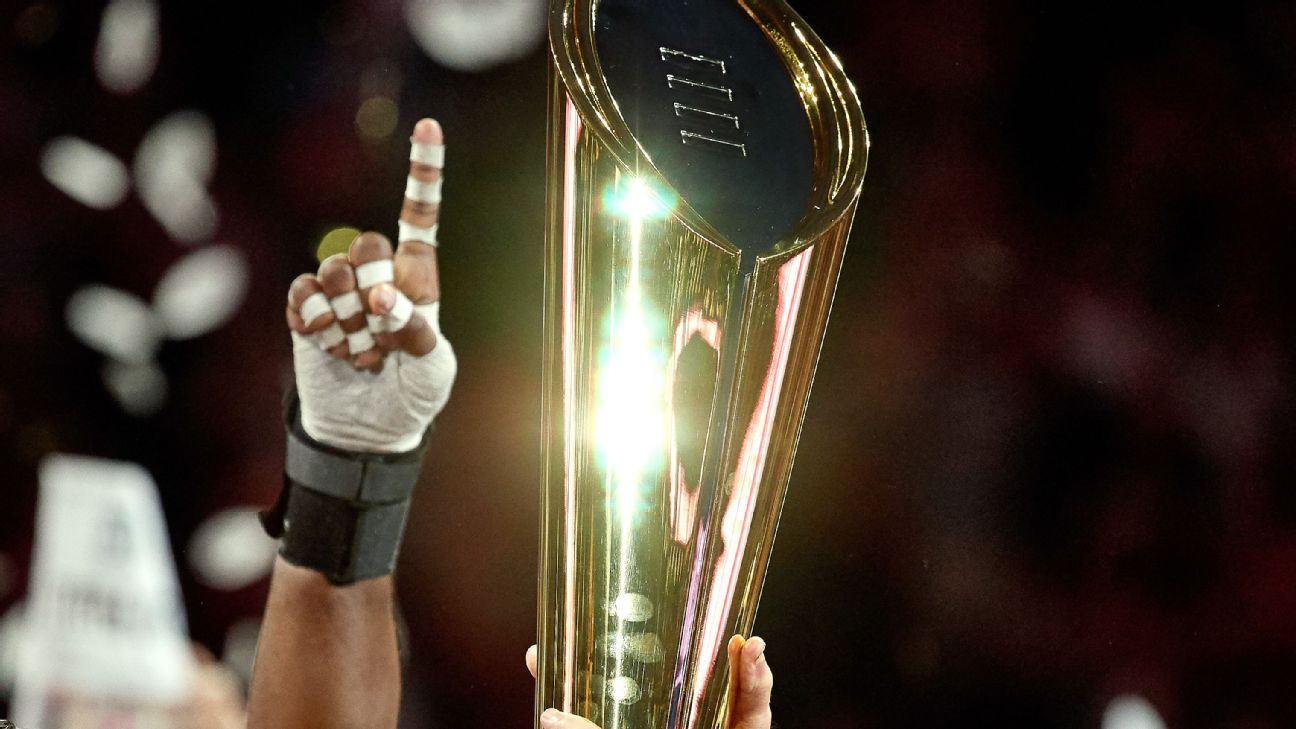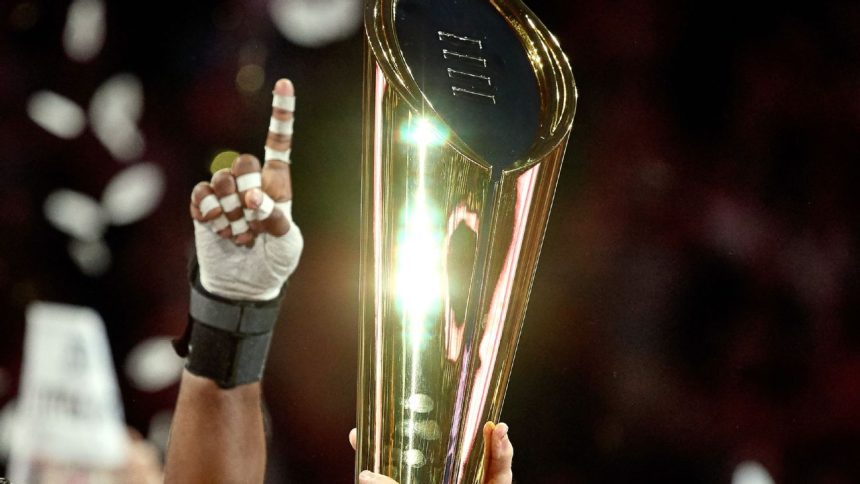
All nine FBS conferences and Notre Dame have agreed to the next College Football Playoff contract, which will begin in 2026 and bring the sport’s postseason much closer to an expected 14-team field with guarantees for conference champions.
The memorandum of understanding guarantees that the field will have at least 12 teams in 2026 and beyond, but sources indicate there is a strong preference for a 14-team field that includes the five highest-ranked conference champions and the next nine highest-ranked teams. Sources caution that the exact format is not finalized, and the Big Ten and SEC will have the bulk of control over that, but others will be protected by parameters that have been put in place and can’t be altered.
“Anything else regarding format is to be determined,” CFP executive director Bill Hancock said Friday. “This is a very important next step for CFP, of course, and we do still have details to be finalized regarding the format, but I want to stress that the really good news is that football fans will continue to see the best teams in the country competing for the national championship on the playing field. This arrangement will also ensure the expanded access will continue to be in place. We firmly believe this, about the importance of a competitive opportunity for more programs and more players and more fans. We’re pleased to be in the position we’re in, while we know there’s still more work to be done.”
The commissioners and Notre Dame agreed that the conference champions from the ACC, Big Ten, SEC and Big 12 and the highest-ranked Group of 5 champion would earn playoff berths, and Notre Dame will have protections that will survive regardless of the ultimate format.
With those ironclad guarantees, the other commissioners and Notre Dame leadership surrendered the bulk of the control over the format to the SEC and Big Ten as “part of the give-and-take,” according to a source.
The new CFP contract goes hand-in-hand with its expected new TV contract with ESPN. Starting in 2026, ESPN is poised to spend an average of nearly $1.3 billion on the playoff for six seasons. The deal would include the final two years on the current CFP contract plus a new six-year agreement for the next iteration of the playoff, sources told ESPN.
Hancock said the negotiations with ESPN for the TV deal are still ongoing but that the CFP is “encouraged.”
“We are encouraged about the position we are in, but we still have work to do,” he said, adding that there isn’t a timetable.
Starting in 2026, the new six-year agreement will codify the further financial separation of the expanded Big Ten and SEC from everyone else in college athletics. The Group of 5 commissioners were in a difficult position without any negotiating power but faced the alternative of being excluded from the CFP.
“It’s like the Godfather’s offer you can’t refuse,” one Group of 5 athletic director told ESPN on Thursday.
Given the conference’s uncertain status with 10 schools leaving next season, new Pac-12 commissioner Teresa Gould did not sign the CFP contract Friday.
The CFP requires a conference to have eight members for its champion to be considered for the CFP. Hancock said the future of the Pac-12’s remaining two members, Oregon State and Washington State, concerning the CFP will “have to be determined under the new arrangement.”
“Oregon State and Washington State are eligible to participate in the CFP this year and next year, and they’ll be eligible in the future depending on what they do, assuming they remain as FBS schools,” Hancock said. “There will be a path for them to participate in the CFP.”
The financial distribution for the expected 14-team playoff will look radically different. On an annual basis, for example, Big Ten and SEC schools will each be making more than $21 million, up from the nearly $5.5 million that schools in Power 5 conferences are currently being paid.
In the ACC, the schools will get more than $13 million annually, and Big 12 schools will get more than $12 million each. Notre Dame is expected to get more than $12 million as well, and sources told ESPN there will be a financial incentive for any independent team that reaches the CFP. There will no longer be a participation bonus for any of the other leagues — a detail that was frustrating to some leaders in the Group of 5.
The Group of 5 schools’ annual payments will increase to just under $1.8 million from the current $1.5 million. According to sources, American Athletic Conference commissioner Mike Aresco was the most outspoken critic of the plan but wasn’t able to garner enough support from other commissioners to fight it.
According to Pac-12 sources, Washington State and Oregon State are slated to earn just $360,000 as independents in the new contract — one-fifth of what the Group of 5 schools would make per year in the new agreement.
Historically, Oregon State and Washington State had each received between $6 million and $7 million annually as members of the Pac-12. They are the only two schools receiving less money in the new revenue distribution agreement.
In addition to both schools ranking among the top 30 in viewership last year, according to sources, part of the Pac-12’s position is that Oregon State and Washington State have been just behind the ACC and Big 12 and significantly ahead of the Group of 5 during the four-team playoff era in the average number of weeks they spent ranked by the CFP selection committee.
Sources caution that the financial numbers are tricky to compare, as there is uncertainty about the fine points of expenses and distribution in the next iteration. But these figures for the annual distributions will be approximately correct.
These numbers are indicative of the changing landscape, where the money from the historic bowl relationship is now repositioned through the CFP.
That’s a different scenario for Notre Dame, which did not have a traditional bowl payout. Notre Dame leadership remains steadfast in its independent status and believes it is well-positioned financially and with its access to the playoff now and in the future, sources said.
Because the Big Ten and SEC will have a combined 34 teams and the most CFP representatives, they have also had the most leverage in the discussions. SEC commissioner Greg Sankey, who met with the conference presidents and chancellors this week, has said his conference has delivered 40% of the teams in the playoff.
That’s also the reason for the ACC’s slight edge in revenue over the Big 12, as the ACC has had eight CFP semifinalists (counting Notre Dame’s appearance in 2020 as a league member), while TCU is the only remaining Big 12 team to reach a CFP semifinal as a member of the conference. Big 12 member Cincinnati earned a CFP berth in the 2020 season when it was in the American Athletic Conference. Oklahoma (CFP appearances in 2015, 2017-19) and Texas (2023) are joining the SEC next season.
The vast disparity in revenue between the top and bottom has already elicited discontent and pushback from schools outside the Big Ten and SEC. To help alleviate some of those concerns, sources said a “look-in” clause for 2028 has been added to give the commissioners and Notre Dame leadership a chance to reevaluate the contractual agreements based on how every league has performed to that point. There’s also a clause that permits that timeline to be accelerated if there is “material realignment” again.
The CFP will use a 12-team format for the 2024 and 2025 seasons. The format for the next two years will be five automatic qualifiers from the five highest-ranked conference champions and seven at-large bids. There is expected to be ongoing discussion about the format for what’s expected to be a 14-team playoff.
The timeline of those crucial decisions is undetermined, as it’s not known whether college sports leaders will let one edition of the 12-team playoff play out or decide in the upcoming months.
Hancock said there also isn’t any deadline for the CFP to determine its future format.
“The next few years are solid,” he said. “I don’t sense any urgency, although I know we would all — fans, coaches, players all of us — would like to get this decided. I want to caution time is on our side here because the next two years are in place.”
This week’s internal Friday deadline was an unusual path forward for an organization that has historically relied on unanimity to proceed with any major changes to the CFP — not only from the FBS commissioners, but also their respective presidents and chancellors who represent them on the CFP board of managers. Because there will be a new contract in 2026, though, the decisions made Friday were based on whether their desire to participate in it outweighed any perceived unfairness in the process or format.













